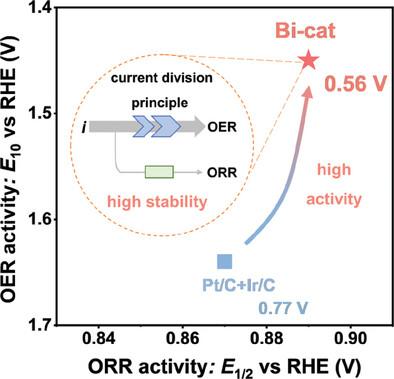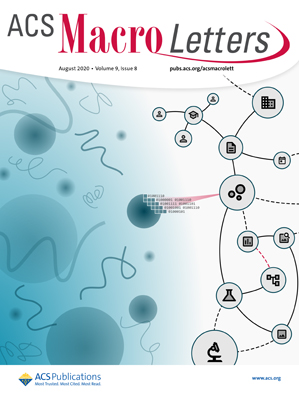利用 ΔE = 0.56 V 双功能氧电催化剂实现高倍率和长循环锌-空气电池
IF 5.1
Q1 POLYMER SCIENCE
引用次数: 0
摘要
锌-空气电池(ZAB)因其低成本、内在安全性和环境友好性而成为前景广阔的下一代储能设备。然而,阴极反应的缓慢动力学严重限制了 ZAB 在实际应用中的性能,因此需要高效的双功能氧还原和进化电催化剂。本文开发了一种超高活性的双功能电催化剂,其ΔE 为 0.56 V,创历史新低,大大优于基于贵金属的基准(Pt/C+Ir/C,ΔE = 0.77 V)和许多其他已报道的双功能电催化剂(大多 ΔE ≥ 0.60 V)。铁基单原子位点和纳米级层状双氢氧化物的纳米级复合使这种双功能电催化剂具有高导电性和大活性表面,从而加强了电子传导和离子传输途径。此外,根据电流分裂原理,稳定性也得到了显著提高。带有双功能电催化剂的 ZAB 具有 198 mW cm-2 的峰值功率密度和超过 6000 次循环的出色耐久性。此外,还构建了安培小时规模的 ZAB,并在 1.0 A 和 1.0 Ah 条件下进行了循环。这项研究打破了双功能氧电催化的活性记录,拓展了 ZABs 用于可持续能源存储的潜力。本文章由计算机程序翻译,如有差异,请以英文原文为准。

Enabling High-Rate and Long-Cycling Zinc–Air Batteries with a ΔE = 0.56 V Bifunctional Oxygen Electrocatalyst
Zn–air batteries (ZABs) are promising next-generation energy storage devices due to their low cost, intrinsic safety, and environmental benignity. However, the sluggish kinetics of the cathodic reactions severely limits the ZAB performances in practical use, calling for high-efficiency bifunctional oxygen reduction and evolution electrocatalysts. Herein, an ultrahigh-active bifunctional electrocatalyst is developed with a record-low ΔE of 0.56 V, significantly outperforming the noble-metal-based benchmark (Pt/C+Ir/C, ΔE = 0.77 V) and many other reported bifunctional electrocatalysts (mostly ΔE ≥ 0.60 V). The nanoscale composite of Fe-based single-atom sites and nanosized layered double hydroxides endows the bifunctional electrocatalyst with high conductivity and a large active surface that afford strengthened electron conduction and ion transport pathways. Furthermore, a remarkable improvement in stability is realized following the current division principle. ZABs with the bifunctional electrocatalyst deliver a high peak power density of 198 mW cm−2 and excellent cycling durability for over 6000 cycles. Moreover, ampere-hour-scale ZABs are constructed and cycled under 1.0 A and 1.0 Ah conditions. This work breaks the activity record for bifunctional oxygen electrocatalysis and expands the potential of ZABs for sustainable energy storage.
求助全文
通过发布文献求助,成功后即可免费获取论文全文。
去求助
来源期刊
CiteScore
10.40
自引率
3.40%
发文量
209
审稿时长
1 months
期刊介绍:
ACS Macro Letters publishes research in all areas of contemporary soft matter science in which macromolecules play a key role, including nanotechnology, self-assembly, supramolecular chemistry, biomaterials, energy generation and storage, and renewable/sustainable materials. Submissions to ACS Macro Letters should justify clearly the rapid disclosure of the key elements of the study. The scope of the journal includes high-impact research of broad interest in all areas of polymer science and engineering, including cross-disciplinary research that interfaces with polymer science.
With the launch of ACS Macro Letters, all Communications that were formerly published in Macromolecules and Biomacromolecules will be published as Letters in ACS Macro Letters.

 求助内容:
求助内容: 应助结果提醒方式:
应助结果提醒方式:


